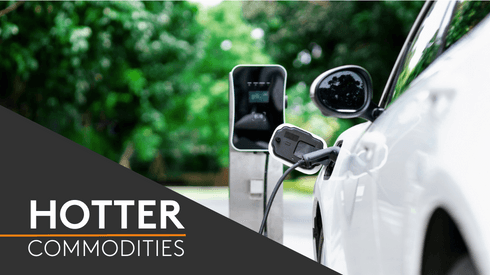Copper concentrate, a key feedstock for copper smelting, is priced according to treatment and refining charges (TC/RCs). The charges are typically discounts to the outright exchange price paid to smelters for processing ore into refined metal. The charge usually falls amid tighter supply.
Fastmarkets’ benchmark copper concentrate TC/RC index fell into negative territory on Friday April 26, marking the first time the index traded as a negative number since Fastmarkets started to track the market in 2013.
Fastmarkets calculated the weekly copper concentrates TC index, cif Asia Pacific, measuring a midpoint between smelter and trader buying levels, at -$2.60 per tonne on April 26, compared with $0.10 per tonne a week earlier.
Meanwhile, copper cathodes, refined metal produced by copper smelters, are trading at discounts for units being imported into China, also for the first time on Fastmarkets records.
Fastmarkets assessed the daily benchmark copper grade A cathode premium, cif Shanghai at $(15)-0 per tonne on April 26, down from a premium of $10-28 per tonne on April 19.
The assessment is at the lowest level on record, dating from 2015, and it is also the first time registered copper cathode has traded at negative numbers.
Unsustainable
The unprecedented negative values happening almost simultaneously in the raw material and finished metal markets have raised strong market interest. Many market participants told Fastmarkets they see the extreme conditions as unsustainable.
“This will not last long,” a copper concentrate trader said. “[The copper concentrate] market deficit [will] remain intact [for the rest of year], but I think spot terms [of TC/RCs] are already at its bottom, and few domestic copper smelters are able to accept buying spot units at low single numbers.”
“The second quarter is key unit maintenance season for domestic copper smelters [this year], and some of them are very likely to prolong maintenance works, and the resultant reduction in demand for copper concentrate will probably ease supply tightness [of copper concentrate], though this will not change the supply deficit picture,” the same copper concentrate trader added.
Spot copper concentrates TC/RCs started to tumble from late last year amid squeezed spot supplies following the unexpected closure of First Quantum’s Cobre Panama copper mine in November 2023. Fastmarkets’ indices have fallen by 103.6% since the end of November 2023 when it stood at $72.90 per tonne / 7.29 cents per lb.
Some Chinese copper smelters called for production cuts amid acute spot shortages of copper concentrate, but no real cuts have been reported. Instead, market participants are observing increased supplies of copper scrap as an alternative feedstock for domestic copper smelters that are securing copper production during the key maintenance season in the second quarter.
“The market expected a big decline in copper cathode output during the second quarter [of this year] due to maintenance works, but it now looks like the impact on copper production will be smaller than expected amid more availability of copper scrap,” a second copper cathode trader said.
“Why import copper cathodes when there are sufficient supplies in the domestic market? This makes [it] more unreasonable [to import cargoes] amid bigger arbitrage losses after copper prices surged,” a third copper cathode trader said.
Fastmarkets’ copper import arbitrage averaged at a loss of $240.52 per tonne between April 2 and 26, widening from a loss of $181.82 per tonne during March following a stronger London Metal Exchange copper price over the Shanghai Futures Exchange copper contract.
Arbitrage terms measure the import opportunity between the LME and SHFE, with a negative arbitrage calculation meaning that an importer could incur a loss.
There has been no significant decline in China’s domestic copper inventories since late February when market participants returned from Lunar New Year holidays that took place on February 10-16. Copper stocks in SHFE-registered warehouses totaled 287,498 tonnes on April 26, up from 181,323 tonnes on February 23, the first trading week following China’s week-long public holiday.
“I think the arbitrage window will remain closed due to the strength of LME copper prices, and this will keep [copper cathodes] import interest muted and premiums low for seaborne units heading for Shanghai,” the third copper cathode trader said. “But a negative number [for trading imported copper cathode] is not expected to stay long. [And] I can deliver my units into warehouses rather than sell at discounts.”
Spot liquidity has been slowing since late last week, with some looking for buying spot tonnages at discounts, but limited business was heard except for some sell-offs of soon-to-arrive units, Fastmarkets learned.
Higher trading risks
Faced with the unprecedented drop in the copper concentrate TC/RCs, certain market participants are exercising more caution due to worries over credit availability and potential counterparty risks, they told Fastmarkets.
“We don’t sell spot units to small-medium copper smelters or traders now as they might default, [and] we won’t take any risks,” a fourth copper miner said.
“We are a bit worried that some smelters don’t have sufficient liquidity to pay units, and there are other potential risks resulting from limited credit lines and hefty financial costs, adding to market risks,” a fifth copper concentrate trader said.
Want to hear more insights on this market? Subscribe to Fast Forward, your definitive podcast for the critical minerals and battery raw materials markets, today. Your host, Andrea Hotter, will address burning topics in the critical minerals market including the latest trends, market buzz and game-changing technologies that are shaking up the sector. Find out more here or subscribe on Spotify, Apple Podcasts, Amazon Music or wherever you get your podcasts to get the latest episodes when they are released.





